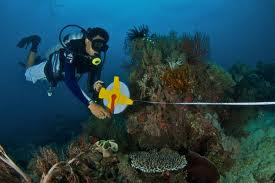The sampling site is located at Pulau Kapas which the site that in front of the Gemia Island. The sample for phytoplankton for epilithic and by using 63 µm and 120 µm was collected near the shore, whereas the epilithic sample was collected from the rocks. For the coral reef and invertebrate survey, the data has been collected by snorkeling and record on the slate board.
Plankton:
a) Epilithic:
First, rocks were collected from the rocky shore. Then, the rocks were brushed with the tooth brush to remove any of phytoplankton which lives within the rocks. A little amount of water was used in order to remove the phytoplankton on the rocks. After make sure that phytoplankton has been brushed, the tooth brush was rinsed with sea water in order to ensure all the phytoplankton has been washed down. The phytoplankton was placed with a little amount of sea water in a sample bottle to bring back to the laboratory for analysis. The sample was preserved with 10% formalin while in the laboratory the sample was observed and counted until 300 individuals of phytoplankton and zooplankton. The phytoplankton and zooplankton was classified until genus.
b) Phytoplankton and zooplankton 63 µm and 120 µm:
Nano plankton net with a mesh size 63 µm and 120 µm was set up by close it valve before it was introduced into the water for collected the plankton. The net is spread as far as possible and being towed back horizontally. When towed the plankton net back, make sure the net is properly being withdrawn and avoid from coiled. Besides, the areas which there are many people must be avoided as the sand might being trapped in the net due to the currents produced by human. When the net has been arrived safely, the valve was opened and the collected sea water was placed in a sample bottle. The sample then was preserved with 10% formalin and brought back to laboratory for analysis. The process was being repeated for three times to get enough samples. In the laboratory, the sample was observed and counted until 300 individuals of phytoplankton and zooplankton. The phytoplankton and zooplankton was classified until genus.
First, 50 m transect line is run underwater. Then, the snorkeler swims and observed macrobenthic communities (coral reef and invertebrates) along the transect line. Data was observed every 0.5 m and recorded on the slate board. The data has been categorized and being calculated for their percentage abundance and density.



No comments:
Post a Comment